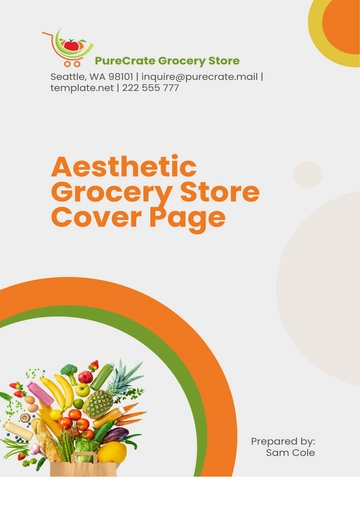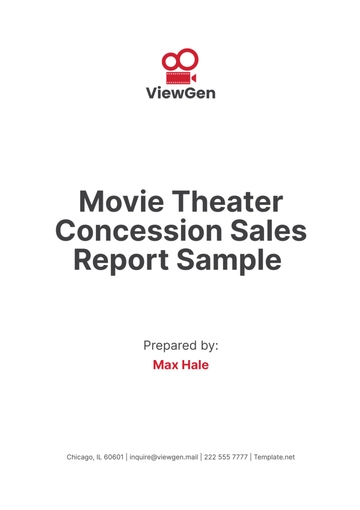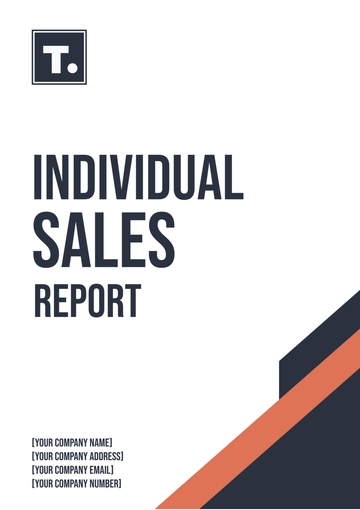Free Online Store Sales Report

I. Introduction
This report provides an analysis of [Your Company Name]'s sales performance in [2055]. It highlights achievements, areas for improvement, and actionable insights to inform future strategies. The report examines key metrics, such as revenue growth, product performance, and customer behavior trends. By analyzing sales data, this report aims to provide a comprehensive understanding of the company’s progress and opportunities.
II. Revenue Comparison
This section compares annual revenue between [2055] and [2054] to showcase the company’s financial growth. The revenue growth reflects the success of increased marketing efforts and an improved product portfolio.
Metric | 2054 | 2055 |
|---|---|---|
Total Revenue | $50,000,000 | $57,500,000 |
Online Sales | $45,000,000 | $52,000,000 |
In-Store Sales | $5,000,000 | $5.5,000,000 |
New Customer Revenue | $20,000,000 | $23,000,000 |
Repeat Customer Revenue | $30,000,000 | $34,500,000 |
New customer acquisition contributed significantly, while loyalty programs enhanced repeat purchases. Online sales saw the highest percentage growth, affirming the company’s focus on e-commerce excellence.
III. Product Performance
This section evaluates the sales performance of various product categories, helping identify key revenue drivers and underperformers.
Top Performers: Electronics and apparel accounted for [55%] of total sales. These categories demonstrated consistent demand throughout the year.
Emerging Categories: Home and lifestyle products showed a [15%] sales increase, reflecting changing customer preferences. These items have growth potential for [2056].
Underperforming Products: Seasonal products underperformed due to inventory management challenges. Addressing this will improve profitability.
Promotional Impact: Products featured in holiday campaigns saw a [30%] boost in sales compared to non-promotional periods. This underscores the importance of targeted discounts.
Inventory Optimization: Overstocks and shortages in certain categories highlight the need for refined demand forecasting. Enhanced planning will minimize losses.
IV. Customer Segmentation Analysis
Understanding customer segments is essential for tailoring marketing and sales strategies. This section reviews performance by customer type.
Customer Segment | 2054 Revenue | 2055 Revenue |
|---|---|---|
New Customers | $20,000,000 | $23,000,000 |
Repeat Customers | $30,000,000 | $34,500,000 |
High-Value Customers (HVCs) | $12,000,000 | $14,400,000 |
Occasional Shoppers | $18,000,000 | $20,000,000 |
Repeat customers remain the cornerstone of revenue, contributing [60%] of total sales. High-value customers displayed the highest growth rate, emphasizing the success of loyalty programs. Focusing on nurturing HVCs and occasional shoppers offers significant revenue potential.
V. Marketing Campaign Effectiveness
The effectiveness of marketing campaigns in [2055] played a critical role in revenue growth. This section evaluates key promotional strategies.
Digital Marketing ROI: Investments in social media and search engine ads yielded a huge return. Digital campaigns effectively reached target audiences.
Seasonal Promotions: Holiday and back-to-school campaigns drove an increase of sales spike during peak periods. Timing and messaging were pivotal.
Email Marketing: Personalized email campaigns resulted in a significant increase conversion rate. Tailored content improved customer engagement.
Referral Programs: Referral incentives increased new customer acquisition. Loyal customers became brand advocates.
Social Media Engagement: Consistent activity on multiple social media platforms enhanced brand visibility. Social commerce initiatives contributed to sales growth.
VI. Operational Efficiency Analysis
This section reviews operational efficiency metrics, including order fulfillment and delivery timelines. Improved fulfillment times and delivery accuracy contributed to customer satisfaction. Investments in operational technology and staff training paid off with measurable improvements across key efficiency metrics.
Metric | 2054 Performance | 2055 Performance |
|---|---|---|
Average Fulfillment Time | 3.5 Days | 3.0 Days |
On-Time Delivery Rate | 85% | 90% |
Order Accuracy Rate | 95% | 97% |
Customer Support Response Time | 4 Hours | 3 Hours |
Returns Processing Time | 5 Days | 4 Days |
VII. Key Challenges and Opportunities
This section highlights the obstacles faced in [2055] and the opportunities for growth in [2056].
Supply Chain Issues: Global disruptions caused occasional delays. Diversifying suppliers and using predictive analytics can mitigate future risks.
Customer Retention: Retention rates improved but still require focus. Enhanced loyalty programs will solidify customer relationships.
Technological Advancements: Implementing AI-driven personalization offers untapped potential. Expanding these tools will improve user experience.
Sustainability Initiatives: Customers increasingly value eco-friendly practices. Expanding sustainable packaging options will align with market trends.
Market Expansion: Untapped regions and demographics offer significant growth opportunities. Targeted marketing strategies will unlock these areas.
VIII. Conclusion
[Your Company Name] achieved strong sales growth in [2055], driven by enhanced marketing, operational improvements, and customer-centric strategies. Comparisons to last year highlight significant progress across key metrics, reinforcing the effectiveness of the company’s initiatives. By addressing challenges and capitalizing on opportunities, [Your Company Name] aims to achieve even greater success in the coming year.
- 100% Customizable, free editor
- Access 1 Million+ Templates, photo’s & graphics
- Download or share as a template
- Click and replace photos, graphics, text, backgrounds
- Resize, crop, AI write & more
- Access advanced editor
Track and analyze your sales performance with the Online Store Sales Report Template. This ready-to-use template provides sections for financial summaries, sales trends, and product performance analysis. Available for customization using the Ai Editor Tool, it empowers businesses to make data-driven decisions and maintain an organized overview of their online store's growth.
You may also like
- Sales Report
- Daily Report
- Project Report
- Business Report
- Weekly Report
- Incident Report
- Annual Report
- Report Layout
- Report Design
- Progress Report
- Marketing Report
- Company Report
- Monthly Report
- Audit Report
- Status Report
- School Report
- Reports Hr
- Management Report
- Project Status Report
- Handover Report
- Health And Safety Report
- Restaurant Report
- Construction Report
- Research Report
- Evaluation Report
- Investigation Report
- Employee Report
- Advertising Report
- Weekly Status Report
- Project Management Report
- Finance Report
- Service Report
- Technical Report
- Meeting Report
- Quarterly Report
- Inspection Report
- Medical Report
- Test Report
- Summary Report
- Inventory Report
- Valuation Report
- Operations Report
- Payroll Report
- Training Report
- Job Report
- Case Report
- Performance Report
- Board Report
- Internal Audit Report
- Student Report
- Monthly Management Report
- Small Business Report
- Accident Report
- Call Center Report
- Activity Report
- IT and Software Report
- Internship Report
- Visit Report
- Product Report
- Book Report
- Property Report
- Recruitment Report
- University Report
- Event Report
- SEO Report
- Conference Report
- Narrative Report
- Nursing Home Report
- Preschool Report
- Call Report
- Customer Report
- Employee Incident Report
- Accomplishment Report
- Social Media Report
- Work From Home Report
- Security Report
- Damage Report
- Quality Report
- Internal Report
- Nurse Report
- Real Estate Report
- Hotel Report
- Equipment Report
- Credit Report
- Field Report
- Non Profit Report
- Maintenance Report
- News Report
- Survey Report
- Executive Report
- Law Firm Report
- Advertising Agency Report
- Interior Design Report
- Travel Agency Report
- Stock Report
- Salon Report
- Bug Report
- Workplace Report
- Action Report
- Investor Report
- Cleaning Services Report
- Consulting Report
- Freelancer Report
- Site Visit Report
- Trip Report
- Classroom Observation Report
- Vehicle Report
- Final Report
- Software Report





























